RESEARCH
We are currently focusing our efforts on researching molecular mechanisms of rice grain filling and molecular breeding of value-added rice. If you would like to know more information on our projects, please click topics listed below.
- Unraveling molecular mechanism of loss of rice grain quality by global warming for development of high temperature tolerant rice
- Development of rice breeding materials with a variety of cooked rice texture
- Studies on the molecular basis of protein accumulation in rice seed and its application to molecular farming
Unraveling molecular mechanism of loss of rice grain quality by global warming for development of high temperature tolerant rice
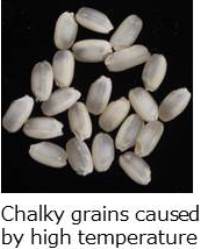
Rice is originally from tropical Asia, but is unexpectedly vulnerable to hot weather. Because of recent global warming, loss of grain quality frequently occurs in a wide area of Japan. Endosperm, the edible part of rice grains, is tightly packed with granules of starch in autumn harvest season, yielding hard translucent grains. However, when rice plant is exposed to high temperatures above 26°C for certain duration in the ripening stage, starch granules do not grow enough and air spaces remaining between granules reflect light, making grains appeared chalky. Such immature grains are easy to crack during polishing, that decreasing commercial value. Therefore prevention of occurrence of chalky grans is a major issue for premium rice production.
Since we do not encounter hot weather every year, enormous time and labor are required to breed high temperature tolerant rice that produces less chalky grains under hot weather. So, we started to investigate what is going on in the rice grains exposed to high temperature. By understanding molecular mechanism related to occurrence of chalky grains and then elucidating key genes, we aim to develop method for breeding high temperature tolerant rice.
Our recent intensive analysis of transcriptome (gene expression) and metabolome (metabolites) using high temperature ripening grains unraveled that increased expression of a starch degrading enzyme, α-amylase as well as decreased expression of starch biosynthetic enzymes hampers accumulation of starch in the ripening grains at high temperature, leading to grains appeared chalky (Yamakawa et al 2007, Yamakawa and Hakata 2010). Then, when we suppressed α-amylase by gene manipulation, the rice produced less chalky grains under high temperature conditions (Hakata et al 2012).
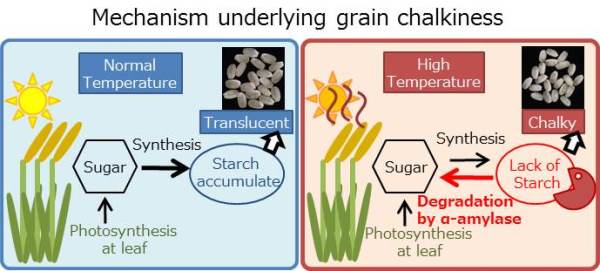
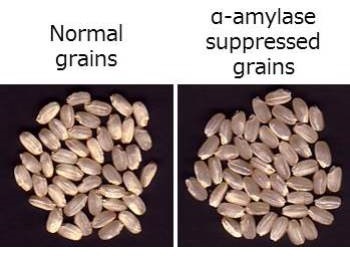
Currently, we are involved in a research project for developing high temperature tolerant rice. By using rice mutant libraries and natural varieties preserved in our country, we are hunting genes enhancing tolerance to stresses such as high temperature, and employing those genes for breeding new rice.
Development of rice breeding materials with a variety of cooked rice texture
Traditionally, soft and sticky rice has been developed to meet the consumers’ preference in Japan. However, due to diversification of food culture, a variety of rice with a wide range of cooked rice texture is needed recently; from soft and sticky types suitable for rice balls and rice-cake sweets to hard and less sticky types for fried rice, curry rice, and beef bowl.
The texture of cooked rice relies largely on the characteristics of starch that accounts for 80% of rice grain weight. Grain starch are composed of long chained glucose polymer (glucan), amylose, and frequently branched glucan, amylopectin. Amylose content has a large impact on rice texture immediately after cooking, and a large amount of amylose leads to hard and less sticky texture. On the other hand, amylopectin affects the texture after cooling, and long glucan branches of amylopectin harden the rice when they are cooled.
The composition and structure of amylose and amylopectin are governed by an array of starch biosynthetic enzymes. Our groups are exploring rice populations to find varieties with a well-balanced combination of starch-related enzyme activities and utilize them for practical rice breeding.
Studies on the molecular basis of protein accumulation in rice seed and its application to molecular farming
Rice seed protein has the best nutritive value among cereals whereas there are poor contributions to food processing property. Usually, high nitrogen fertilization is recommended for enhancing grain yield, but seed protein content increases under such condition and resulting rice often shows less eating and processing quality. Control of seed protein accumulation and improvement of rice seed proteins are the important themes for rice production in the future.
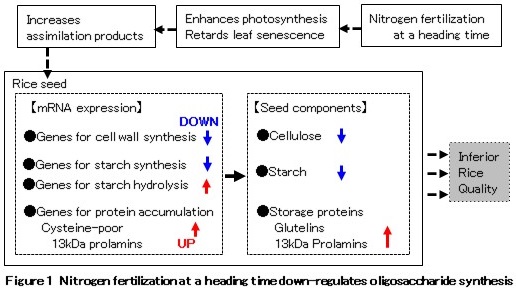
Storage proteins, such as glutelin, prolamin, and globulin, are the most abundant protein species in seed, and are used as a nitrogen source when seed germinates. They are deposited into the storage organelle called protein body 1 (PB1, for prolamin) and protein body 2 (PB2, for glutelin and globulin). Our first research target is the process of PB formation and total seed protein accumulation. For example, nitrogen fertilization at a heading time accelerated amino acid synthesis and increased the amount of particular storage proteins (glutelins and cys-poor 13kDa prolamins) whereas the synthesis of glucans, especially cellulose, decreased (Midorikawa 2014). The cys-poor 13kDa prolamins are deposited outer area of PB1, suggesting that they contribute to enlarging PB1 and keeping nitrogen for seed germination (Saito 2012). Now we are also interested in the relationship between the cellulose content and the rice quality.
The other research theme is improving rice seed proteins using transgenic technology. Recent studies on molecular farming have pointed out the usefulness of crop seed for the production of recombinant proteins. Our research about rice seed protein brought a novel idea for such purpose (Kuroda, Patent JP4644777). It is useful for high-level accumulation of pharmaceutical proteins in rice seed (Shigemitsu 2012, Yuki 2013 and 2016, Tokuhara 2013), and medical researchers try to develop a rice-based oral vaccine called ‘MucoRice’ (Yuki 2013, Mejima 2015, Takeyama 2015, Kashima 2016). MucoRice can be stored long time without refrigerators and easily deliver to all over the world with no special facilities. Our research also provides a basis of efficient production of various pharmaceutical proteins in rice seed as well as the case of MucoRice. Crops are good factories based on a natural energy.
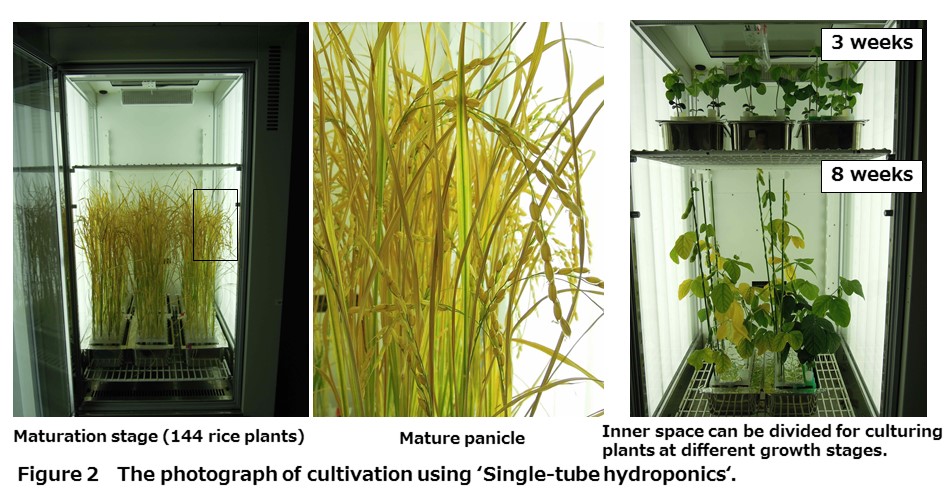
Besides the investigation described above, we developed some tools for accelerating biological experiment. A simple set of plasmids for multi-gene-introduction into plants (Kuroda 2010) contributes various transgenic studies. In addition, a simple method called ‘Single-tube hydroponics’ for high-density crop cultivation (Kuroda 2015) will also assist various crop breeding as well as transgenic studies. Please see our publications for more information.
